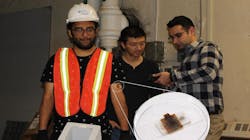Penn State, Ohio State Get NSF Grant to Use AI to Reduce Construction Worker Injuries
The construction industry continues to suffer from a very high rate of injuries. In 2020 there were more than 1,000 fatal work injuries and in 2021 there were 169,200 nonfatal work injuries.
To address this situation, the National Science Foundation is providing a four-year, $1,8000,000 grant to Penn State and The Ohio State University to develop an artificial intelligence (AI)-enabled, real-time, and context-aware holistic health monitoring approach for construction workers.
Houtan Jebelli, an assistant professor is leading a research team. In an article on Penn State's website, he notes that while currently there are wearable sensors, such as headsets that measure brain activity or wristbands that measure cardiac activity, there are not any sensors available that can record multiple physiological signals together.
“We want to design and fabricate a flexible wireless sensing device that can capture workers' diverse physiological signals and biological markers to the stressors in the field and can be worn in a way that is non-invasive and non-disruptive to workers,” he said, in a statement. “We also want to develop innovative machine learning algorithms and frameworks to infer meaningful cues from the elicited bodily responses for continuous and real-time assessment of workers' holistic health conditions. Importantly, we must also maintain workers' privacy.”
In terms of technical development, the researchers will use a digital twin-assisted mechanism, which can be used for simulations as well as forecasting. This system is able to preserve employee privacy as it creates a digital health map with information that isn't traced to specific employees. But the system is able to provide personalized health to specific employees. One example cited is letting them know if they are becoming overheated so they can take steps to correct that.
“The goal is to integrate the crowdsensing of workers' de-identified health measures and digital twin technology to generate a comprehensive health map of the construction workplace so that the safety managers get the aggregated health information of the job site,” Jebelli said. “To ensure workers' privacy, managers won't be able to identify the specific worker who is exposed to, for example, high physical fatigue. But they could identify the locations at the job site where stress is highest, or where workers are most fatigued, and then better identify the hazards of their job site.”
Another advantage this project will address is the ability to filter our irrelevant data by using computationally efficient algorithms for real-time noise removal of signals in the field. “When we do physiological sensing for a subject at a hospital, for example, we can catch a high-quality signal in real-time because we can control the environment and subjects movement,” Jebelli said. “But when you are doing physiological sensing in the field, we can not control the environment, and we cannot ask workers to stay in a stationary condition because movement is the nature of the job. High-intensity activity brings a lot of signal noise, and current signal processing methods are not robust in reducing such noise in real-time. We want to address this.”
Photo Caption
From left to right: graduate student Amit Ojha, The James L. Henderson, Jr. Memorial Associate Professor of Engineering Science and Mechanics Huanyu "Larry" Cheng and Assistant Professor of Architectural Engineering Houtan Jebelli examine the performance of the proposed flexible sensing mechanism.
About the Author
EHS Today Staff
EHS Today's editorial staff includes:
Dave Blanchard, Editor-in-Chief: During his career Dave has led the editorial management of many of Endeavor Business Media's best-known brands, including IndustryWeek, EHS Today, Material Handling & Logistics, Logistics Today, Supply Chain Technology News, and Business Finance. In addition, he serves as senior content director of the annual Safety Leadership Conference. With over 30 years of B2B media experience, Dave literally wrote the book on supply chain management, Supply Chain Management Best Practices (John Wiley & Sons, 2021), which has been translated into several languages and is currently in its third edition. He is a frequent speaker and moderator at major trade shows and conferences, and has won numerous awards for writing and editing. He is a voting member of the jury of the Logistics Hall of Fame, and is a graduate of Northern Illinois University.
Adrienne Selko, Senior Editor: In addition to her roles with EHS Today and the Safety Leadership Conference, Adrienne is also a senior editor at IndustryWeek and has written about many topics, with her current focus on workforce development strategies. She is also a senior editor at Material Handling & Logistics. Previously she was in corporate communications at a medical manufacturing company as well as a large regional bank. She is the author of Do I Have to Wear Garlic Around My Neck?, which made the Cleveland Plain Dealer's best sellers list.
Nicole Stempak, Managing Editor: Nicole Stempak is managing editor of EHS Today and conference content manager of the Safety Leadership Conference.
